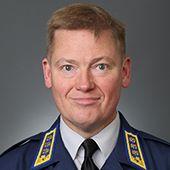The Perspective of Lt. General Kim Jäämeri
My last official interview in Finland during my visit to Finland in February 2018 was with the former head of the Finnish Air Force and now Deputy Chief of Staff, Strategy for the Finnish Defence Forces, Lt. General Kim Jäämeri.
In my discussions in Helsinki, I was increasingly persuaded that a number of core foundational elements in the Finnish approach were very symmetrical with the changes unfolding in 21st century military technology and changes in approach which most liberal democracies needed to make as we shift from the land wars to higher tempo operations.
The mobilization focus of Finland which I discussed with Jukka Juusti, Permanent Secretary Defence, was one aspect.
The other which I discussed with Lt. General Jäämeri was distributed ops.
Clearly, a number of key aspects of military technological change are underscoring greater capabilities for force generation in terms of distributed operations and shaping C2 systems which can support mission command approaches to directing a distributed force are part of significant change going on in the U.S. military as well as other allied militaries.
But for the Finns, distributed operations is in their defense DNA.
They have been living under the threat of missile and air strikes for a long time and have never assumed that you operate from fixed bases alone as crises strike.
Dispersal and distributed operations are at the heart of how best to deal with a significant offensive threat.
And in major exercises like Arctic Challenge, the Finns are demonstrating how their legacy approach is informing their way ahead and how it can be modernized as new systems are being added to the liberal democratic force structure.
Lt. General Kim Jäämeri: “It is becoming clear to our partners that you cannot run air operations in a legacy manner under the threat of missile barrages of long range weapons.
“The legacy approach to operating from air bases just won’t work in these conditions.
“For many of our partners, this is a revelation; for us it has been a fact of life for a long time, and we have operated with this threat in the forefront of operations for a long time.”
What clearly is new or evolving is the key role of exercises for Finland and the cross-learning which comes for both Finland and its exercise partners.
Finland passed legislation last year which allows Finland to both provide and receive military assistance which provides the legal framework for shaping ways ahead in exercising with other militaries and shaping cross learning in the military operational domain.
Lt. General Kim Jäämeri: The legislation has brought logic to our exercise structure.
“It also clarifies how the European Union Treaty 42.7 would be practically executed; if someone asked for assistance, then now we have in place the procedures and structures to take proper decisions to provide for assistance.”
With the enhanced concern about the military situation in Europe after the events in Crimea obviously there has been enhanced focus within Europe on territorial defense.
With the Finns, this has clearly seen a renewed emphasis on force readiness and an ability to act more effectively in a crisis.
Lt. General Kim Jäämeri: “We have enhanced our focus on crisis management and the role of the military within overall crisis management.
“We have increased our investments in force readiness.
“With regard to our partners, their enhanced focus of attention on defense, whether it be the actions of Sweden, Norway or Denmark in the region, or by the United States within NATO with regard to the EDI-related investments, has been appreciated.
“And as we expand our exercise regime, we are cross-learning with regard to capabilities necessary for our defense.
‘You have to leverage your partnerships more to enhance crisis stability.”

